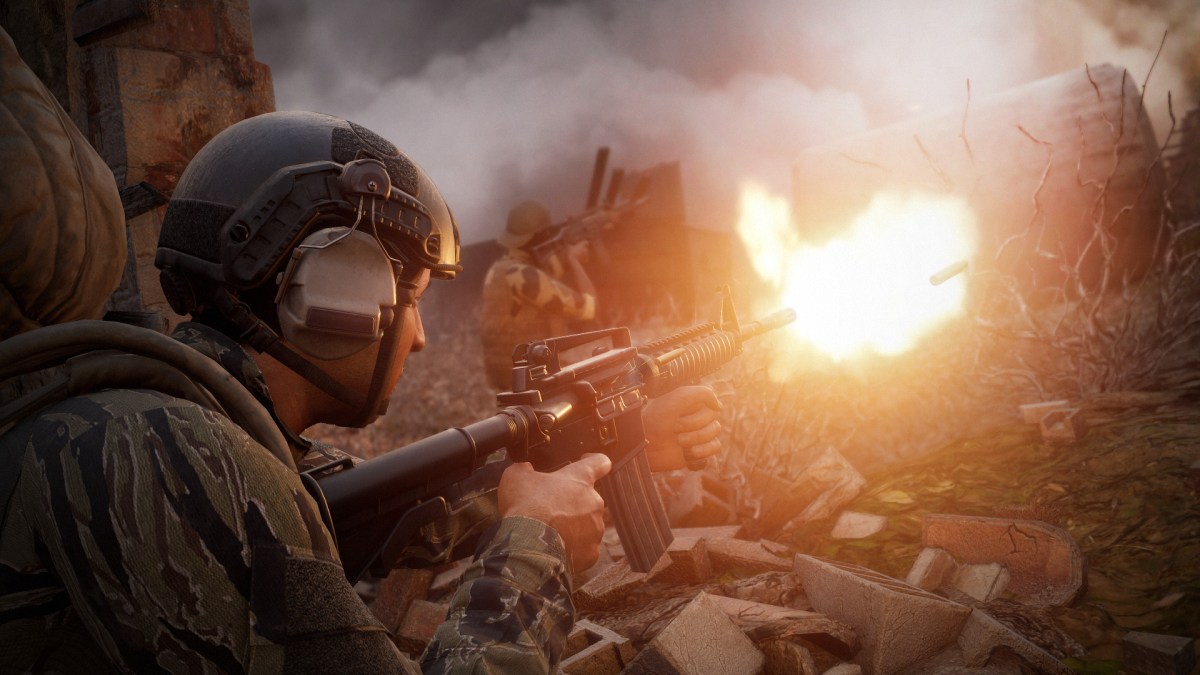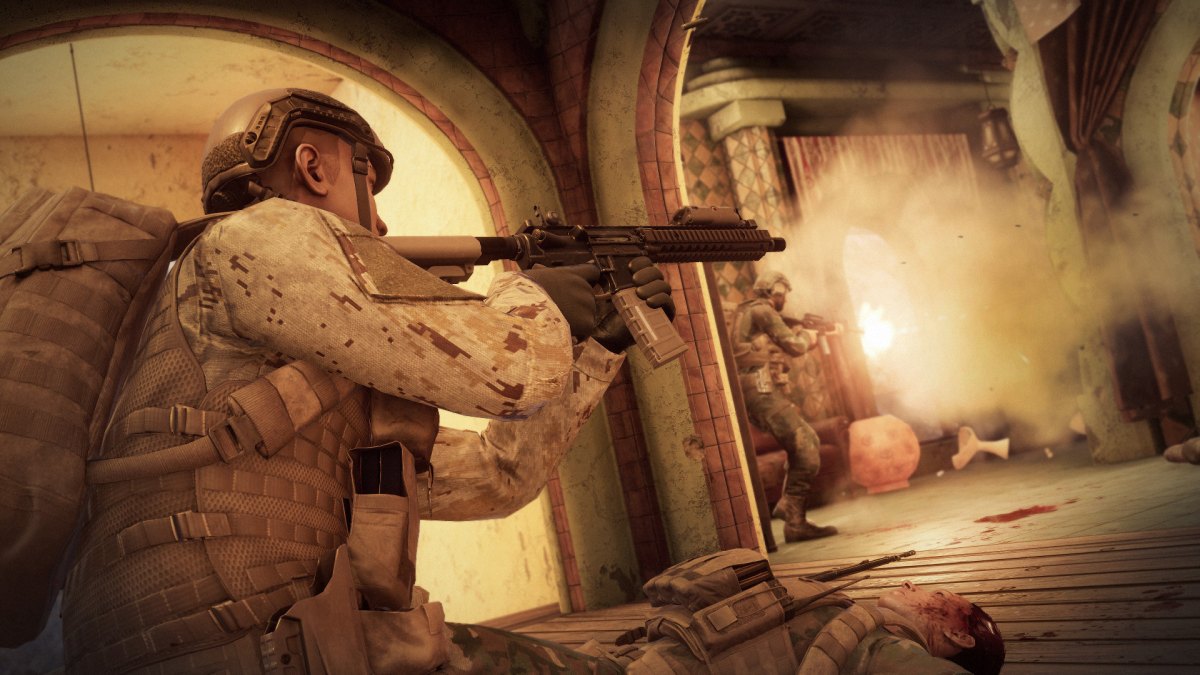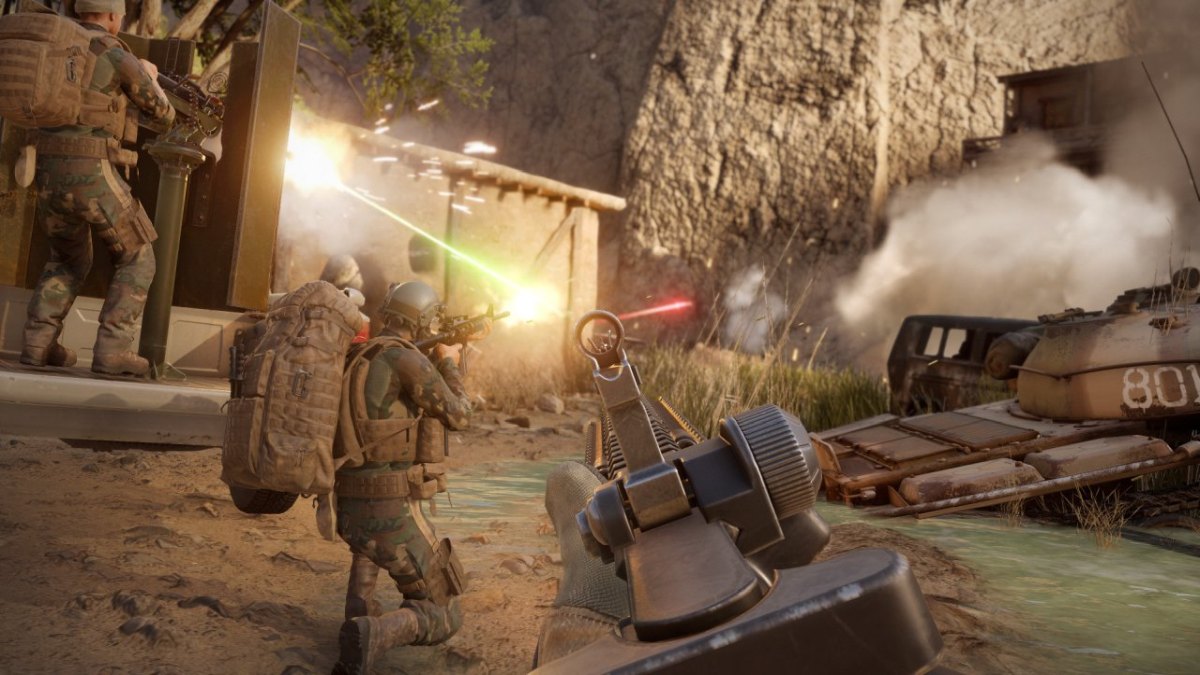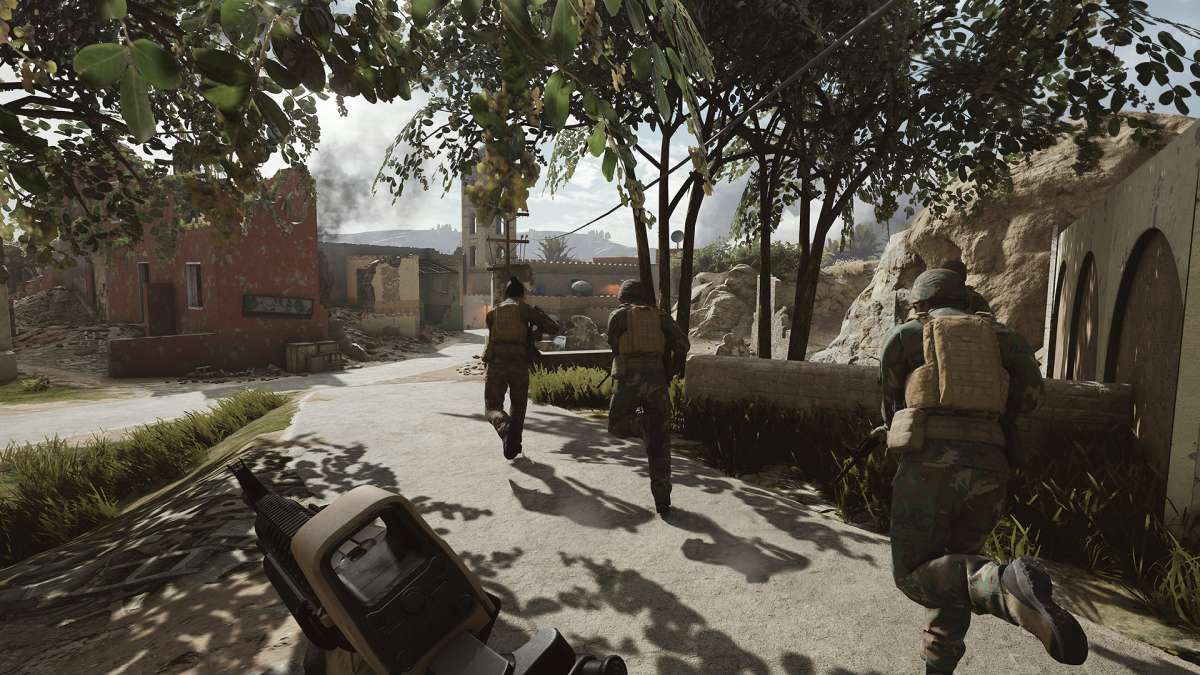Sporting a new engine, big new features and even bigger ambition, Insurgency: Sandstorm, the sequel to the mod-turned-indie FPS hit Insurgency from developer New World Interactive, released at the end of last year to critical acclaim.
Now, with more than 500,000 players having played the tactical FPS and hot on the heels of the game’s first major content update, we spoke with New World Interactive community manager Alex Blonski to learn more about listening to player feedback, plans for the future, the newfound popularity of tactical shooters, whether or not Insurgency: Sandstorm might ever go into battle royale territory, and much, much more.

Q: Insurgency: Sandstorm’s first major content update just released last week. Tell us more about what all that includes.
The new update has been a long time coming for us. I think the last update was December 21st, so it’s been a bit over two months. We’ve been working through all the bugs, feature requests and that sort of thing from the community, trying to get as many of them into the game as we possibly can. At the same time, we’ve been working on new content including a new game mode; basically an Arcade game mode where we can switch between simple game modes and make adjustments overtime, so it stays fresh — almost like a new game mode every month or two. [The plan is to] put those in on a rotating basis. People that also host community servers, host their own servers, they can run those whenever they want after that point. The point of that is we are going to start these smaller game modes that we’re going to be rotating in and out over time so we have something fresh for people to look at. There’s also a lot of new weapons in the game, including two variants of the MP5. We’ve got a couple new machine guns, one for each side, as well as a replacement pistol for the Glock. Lots of new stuff and we’re hoping to continue pushing these updates over time.
If you know anything about our last game we continued doing updates for three years, for the original Insurgency. While we can’t commit to a specific amount of time that we’ll do it [update support], that’s kind of the model we want to follow, having a very long tail in terms of updates for the game.
Q: You mentioned listening to the community for this most recent update. What kind of features have players been requesting and how influential is the player base in charting the future of the game?
It’s interesting, basically our community, because we are kind of situated in between being a very hardcore, mil-sim (military simulation) type of shooter and almost like a casual shooter like Call of Duty or somewhere in the middle, we get influences from both sides of what they [players] want. The really hardcore mil-sim guys want very realistic weaponry, they want new maps that reflect a bigger area they can play in. The guys that want hardcore shooter stuff want gameplay changes, performance based stuff, because they are very much twitch shooters. And then you have people who like specific type of game modes. We have co-op only players. That’s become a huge game mode for us in terms of our player population and something players have been taking more seriously. In other games, usually playing versus AI is something that is a beginning game mode, a teaching game mode. There are guys in our community, they’ll have custom servers, they’ll put bot difficulty as high as they can, adjust it as much as they can, put in way more bot waves than you’d ever think possible, and see how far they can push their own personal limits against a wave-based or capture-based system.
So we have to satisfy all those different groups. I think what we’ve learned over time, starting as a mod and then moving on to the original Insurgency, which was an indie game, is that we have to listen to our playerbase. We do not have the same marketing resources that a lot of AAA game publishers and game companies would. It’s important for us to satisfy our community’s needs. Word of mouth and them being satisfied with the game is how the game gets passed around and how 8 million people own a copy of the original Insurgency.
Q: What is the split between the playerbase of Co-op and PvP? Is there a lot of crossover, or does it seem like people who play Co-op mostly just play Co-op and people who play PvP just play PvP?
There is some crossover. Some people do play both. But typically what people do is they find the game mode they like and they stick with it. Guys who are competitive players, they will play the 5v5 Competitive mode and that’s pretty much all they’ll play, unless they want some downtime to relax and they’ll play a round of Push or something like that. The Co-op guys, usually you’ll have guys who go in there to relax and take a break from PvP, but I’d say generally the community is split between those game modes and they’ve found which ones they like already. There almost seems to be an even distribution between our most popular PvP mode and our Co-op mode right now. But some of our other modes, like Competitive, are catching up as well.

Q: You said you’re hoping to be updating the game for years to come. I know there was a single player campaign that was cut over the course of development. Is that something that could come back? Is there player demand for that, is it something players are passionate about?
I think it’s difficult for players to be passionate about it because of how long ago we decided to cancel it for the launch, but we do hear people asking about it. The original idea for that game mode was to have a female character in a different environment and atmosphere than you’d see in most military shooters, especially bombastic AAA ones, and tell a unique story with it. I think there were a lot of people who found that interesting.
For us on our side, I think early on we bit off a bit more than we could chew in terms of the amount of resources it takes to put out a single player version of the game. Going forward our primary focus is making sure we get some quality of life features in for people to keep people playing over a period of time and getting the console version ready for people who want it on console, because there are a lot of them — to serve them with an experience they don’t normally get, a more hardcore shooter on console. Typically big mil-sim games are PC only, so it’s something we’ve seen a lot of demand for. We haven’t ruled out going back to the single player storyline or releasing it in bits and bites, but right now those are our major focuses, really polishing the game for our PC playerbase and working towards a console launch later this year.
Q: You mentioned adding quality of life features, what are some examples of that?
A few things. Optimization is a big thing, trying to make sure as many people as possible can play the game. Not only trying to make it run better on people’s systems that own the game now but for people who played our original game. [The original Insurgency] was on an older engine, and if we can polish down [Insurgency: Sandstorm] even more to let even more people play the game, that’s very big for us.
Another big thing is community servers. We’ve added a cosmetic system inside the game, you earn experience by playing games, but right now the only way to get experience is to play on a NWI (New World Interactive) server, just so we don’t have people creating their own servers, putting in a billion waves, turning down bot A.I. or having a custom level in a small space and just reaping those points. One of the big things is to have a method to allow these community servers to start earning that experience. It sounds like a small thing, but in the original Insurgency, a lot of people would go into community servers where, it’s like Cheers (laughs), you build up a community through that and you go where everybody knows your name. You start playing with them, some of those servers would have their own leaderboards and tracking, you’d try to get to the top of that, it has a custom ruleset you like. For us on our side, it’s making sure we lock down the experience to servers that go by a specific set of settings standards, basically they are approved for experience to be gained on those servers so we aren’t adding it to ones where you’re changing that ruleset beyond what would be on one of our servers. It’s something we are working on, hopefully that should be coming a bit sooner than the two month gap we had in the last update. This last update took a little bit longer because we were changing over to the latest version of the Unreal Engine at the same time as well. It delayed us a little bit.

Q: The original Insurgency was on Source engine, and now you’re on Unreal. What kind of challenges did that present that the team had to overcome?
The majority of the team had been using Source basically their entire career. We hired a lot from the original Source modding scene for a lot of our development team, so it’s [Unreal] a brand new engine we haven’t touched before, it’s a lot newer. Everything in Source, Source isn’t updated that often at this point. I think they literally released their last major update this week in the last year. It’s old, it hasn’t been updated, so everything there is to find out about that engine has already been found out.
Moving to Unreal, it’s cool because it gives us a lot of different options and, of course, graphics capability that we’ve never had before. There’s a huge community in terms of development as well because there are a lot of games that are using the Unreal Engine at this point, so we can lean on a lot of the development community in terms of making changes to the game, optimizing it, inserting new features. It’s not like we lose out on that. I know the downside, something that was hard to foresee, is there are a lot of people who could run our old game. Our old game could basically run on a potato, so a lot of people didn’t get to come with us [to Insurgency: Sandstorm] or came with us without looking at stuff like system requirements and thought the game would run like it was on a 10-year-old engine. That part has become harder. We’re working to get as much graphical prowess and make the game run as fast as possible so we can get as many as people possible from the original community into this game. Like I said, we have a long tail and people’s systems will continue to get better over time and we’ll continue to make the game run faster over time.
Q: Earlier you mentioned Arcade mode. New modes, are those going to be limited to Arcade mode, or is there a chance for a more permanent core mode to go along with some of the existing ones?
I think it’s possible to get more game modes in there. I think the interesting part about Arcade is that it’s there as a fun side addition and it’s refreshing for people when they go in there once in awhile to see something new. The bigger game modes, the thing we do want to avoid is we don’t want to split our community too much. We’re not Apex Legends or something like that where we have a billion players playing at any given time. So it’s important to keep people together as much as possible. The more divisions, the more options you get for them to split from each other, the harder it is to keep people together. If we do add more game modes, we want to make sure they are going to continue to grow the community and that we’re serving either a new playerbase or that our older playerbase is going to continue to grow over time. We do have ideas, and, of course, our community has sent us a ton of ideas, but we’re trying to be sure if we do work on a new game mode, it’s going to continue to grow our community.
Q: So you’re saying a battle royale mode is still on the table then?
(Laughs) I wouldn’t rule it out. It’s not something we are actively working on or planning, but any of these game modes, you have to make sure your map system, every little bit is thought out. You can’t just throw a game mode out there and assume people are going to love it or do no testing on it and just create a ton of game modes. We had a lot of game modes in the last game and some of them just didn’t get played. You want to make sure you’re working on the things that are going to benefit the most people or what people are asking for in terms or modes or weapons or whatever features people are wanting you to add.
Q: Are there any plans for future maps to expand out of the Middle-Eastern setting, or is that the focus for now?
I think right now we are focusing on the Middle-Eastern environment. We have a lot of maps in the hopper that look a little bit different from the desert landscape that we have with a lot of our maps right now. In the original Insurgency, it’s kind of the same thing, we went to a lot of different places inside that environment that people don’t think about. We had a mountain map in the last Insurgency where it’s all snow-covered. People assume it’s not Middle-East, at least if they’re North American or European and don’t know much about the Middle-East. There’s mountainous regions that have snow. You can do indoor environments. In the last game we had Ministry, which is an almost entirely indoor map in a gigantic ministry building. You can switch up the type of environments pretty easily. We want to maintain an aesthetic. I don’t want to say we’ll never go to another environment, but we want to get through the maximum environments that we have right now in this aesthetic.
The cool part too is community maps. That’s the first modding thing we want to do, allow mapmakers to go out there and make their own maps. If they have cool ideas we’ve promoted those maps in the past and have worked with map creators to get those maps as official maps in the game, and some of those creators have gone on to be hired by the team or paid for their services. We’ll continue to look at doing that as we release support for custom map development.
Q: What is the mod support like right now?
The first thing will be custom map support. And then we’ll try to get a lot of the same support for mods like custom voice lines, UI changes. People went hogwild with our last couple games so we want to see how far we can push that inside the Unreal Engine. That will come a little bit further down the road. We’re going to start out with custom map support.

Q: Realistic shooters, games like PUBG, Rainbow Six Siege, and of course Insurgency, are having a bit of a resurgence recently. Do you have any insight as to why you think that is?
I think as players develop over a period of time, they also want more complexity inside their games, so not just “I’m going to run-and-gun, run-and-gun, run-and-gun.” That’s the typical style you see in a AAA shooter. Some people want to have a more tactical experience as they grow as players, they get better and expect more. There has been a pretty decent market for realistic shooters over time. You have your Armas (America’s Army) and Escape from Tarkov on the very realistic end. For those guys, they sometimes want a break from that style and have things happen a little bit faster. So we kind of position ourselves in the middle of all those with our game mechanics. We take some of the realistic elements, or authentic elements, from the military-sim shooters and some of the pace and faster mechanics, more fun mechanics, from the Call of Dutys and Battlefields and mash them together with our own mechanics, and you have Insurgency: Sandstorm.
It’s really weird. You find people inside of our game, because they come from these different backgrounds and communities, they play the game really different. You see that even when they get higher up there in skill level. Some will be methodical and slow and peek around every corner and communicate a lot. And you have people who rush out into the middle and play it as a run-and-gun style. Both are viable tactics and can be used at any given point as long as the player is good at them. We do have very fast paced Competitive players who play at a really fast pace, trying to out-speed others, and you have the guys who are playing and just holding angles tactically. It’s funny to see those metas develop over time and how players gravitate towards one side or the other depending on what games they’ve played.
I think there are these middle grounds. The first person-shooter market is so big, you can cut off a slice of that and have something. It’s this rainbow of games, all these military games, you can slot them into basically a chart from most realistic and the fastest to the most realistic but the slowest, and you can probably name 15 games at least that are very popular and are getting played a lot even years after they’ve launched. Indie game development has made a much easier path to get your game out there and give gamers a lot more options in terms of the style they want to play.
Have feedback for New World Interactive on how to improve Insurgency: Sandstorm? You can share your thoughts here. To learn more about Insurgency: Sandstorm or share your expertise with other players, check out the Official Insurgency: Sandstorm Wiki.
